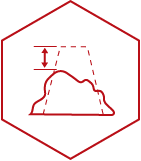
Concrete is composed of four main ingredients: cement, water, fine aggregate (sand), and coarse aggregate (rock). Sometimes recycled cementitious materials known as slag and fly ash are substituted for cement, causing varying effects on the concrete’s plastic and hardened properties. Admixtures can also be supplemented to the mix in order to reduce curing time, increase workability, increase strength, or to change the material properties. Varying proportions of these main ingredients are what create the many types of concrete.

Air improves the durability of concrete in environments that are subject to freezing, thawing, salts, ground water, and alkali reactivity. It also helps improve the workability of concrete. These tiny air pockets relieve internal pressure on the concrete by creating chambers for water to expand into when it freezes. The percentage of air is typically between four and eight percent of the concrete’s total volume, but may vary depending on customer request and special conditions.

While concrete is an excellent material for building and has outstanding strength compression, it ranks weak in its tension. When concrete is combined with materials that have strong tension, such as steel reinforcing bar (rebar) or wire mesh, it can resist tension and increase flexural strength.

Slump is the measure of concrete consistency and fluidity. It shows the flow and overall workability of freshly mixed concrete. Simply put, the higher the slump, the wetter the mix. Four-inch (4”) slump is very common with normal weight concrete and is a good for pumping. Slumps that are above average will cause reduced strength, durability, and permeability of the concrete. Admixtures should be used instead of water to achieve higher slumps so that you can maintain the quality of your concrete.

The water-cement ratio is the ratio of the weight of water to the weight of cement used in a concrete mixture. This is critical to the overall quality of the concrete. A lower water cement ratio allows for increased compressive and flexural strength, reduced shrinkage cracking, lower permeability, and a better resistance to wear ad weather. However, this often decreases the workability of the concrete making it more difficult to place. Water-cement ratios typically range between 0.4 and 0.6. Lower water-cement ratios are used for higher strength concrete.

Weather plays a major role in the placement, finish, and lasting durability of concrete. Interior concrete is typically not exposed to natural changes of the environment and often does not require any air entrainment as it has less of a tendency to crack than exterior concrete. The major difference remains in the finish of the concrete. Finishing exterior concrete too early (before the excess water has time to rise to the top) can trap the bleed water, setting the stage for other surface problems. Exterior concrete usually has a “rough broom” finish to provide traction for vehicles and pedestrians, reducing the chances of any slipping or falling.

Concrete is sensitive to temperature, setting quicker in hot weather and slower in cold weather. Admixtures are often added to slow the set time during hot weather (retarder) and to speed up the set time in cold weather (accelerator).
When pouring fresh concrete, hot weather may cause difficulties such as:
Be careful when adding water to the concrete at the jobsite as it can adversely affect the concrete causing decreased strength, durability, and increasing the tendency to crack.

